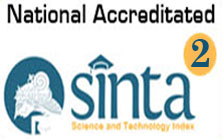Finger Exoskeleton in Simple Motor Rehabilitation Therapy on Arm and Hand Muscle Ability of Post-Stroke Sufferers
DOI:
https://doi.org/10.31965/infokes.Vol19.Iss1.340Keywords:
Finger Exoskeleton, Muscle Ability, Post Stroke, Motor RehabilitationAbstract
Post-stroke sufferers will generally experience weakness on one side of the body, balance, vision, sensory, motor, and cognitive. In West Kalimantan, the estimated stroke sufferer in 2013 was 25,195 people. Based on data from the Public Hospital of Dr. Soedarso Pontianak shows a significant increase from January 2018 to December 2018 totaling 722 people. The research objective was to assess the effectiveness of the finger exoskeleton tool in simple motor therapy on the ability of the client's arm and hand muscles after a stroke. This study used a quantitative approach with a quasi-experimental design. Pre-test and Post-test Nonequivalent Control Group with two groups, which were the control group of 12 people and the intervention group of 12 people with finger exoskeleton tools. The statistical test used was the independent t test and paired t test. Measurement of muscle ability with the Action Research Arm Test. Analysis of the difference in total scores between before and after treatment in the intervention group using Paired T-Test obtained a p-value of 0.000 (p value <0.05) and in the control group using the Wilcoxon test a p-value of 0.016 (p value <0.05). It shows that there is a significant difference in the total score between before and after finger exoskeleton therapy and range of motion. Intervention of finger exoskeleton assistive devices in simple motor rehabilitation therapy is effective in increasing the ability of the client's arm and hand muscles after stroke. It is recommended to make another finger rehabilitation tool with a more optimal design according to the parameters, which are the severity of the client after stroke, subject kinematics, control of movement torque and adaptation between the subject and the robotic device used.
Downloads
References
Agarwal, P., Fox, J., Yun, Y., O’Malley, M. K., & Deshpande, A. D. (2015). An index finger exoskeleton with series elastic actuation for rehabilitation: Design, control and performance characterization. The International Journal of Robotics Research, 34(14), 1747-1772. doi: https://doi.org/10.1177/0278364915598388 DOI: https://doi.org/10.1177/0278364915598388
Cafolla, D., & Carbone, G. (2014). A study of feasibility of a human finger exoskeleton. In Service Orientation in Holonic and Multi-Agent Manufacturing and Robotics (pp. 355-364). Springer, Cham. DOI: https://doi.org/10.1007/978-3-319-04735-5_24
Carrera, E., & Tononi, G. (2014). Diaschisis: past, present, future. Brain, 137(9), 2408-2422. doi: https://doi.org/10.1093/brain/awu101 DOI: https://doi.org/10.1093/brain/awu101
Feigin, V., Norrving, B., & Mensah, G. (2017). Global Burden of Stroke. Circulation Research, 120, 439–448. doi: https://doi.org/10.1161/CIRCRESAHA.116.308413 DOI: https://doi.org/10.1161/CIRCRESAHA.116.308413
Ghani, L., Mihardja, L., & Delima, D. (2016). Faktor Risiko Dominan Penderita Stroke di Indonesia. Buletin Penelitian Kesehatan, 44(1), 49-58. doi: https://10.22435/bpk.v44i1.4949.49-58 DOI: https://doi.org/10.22435/bpk.v44i1.4949.49-58
Haast, R. A., Gustafson, D. R., & Kiliaan, A. J. (2012). Sex differences in stroke. Journal of Cerebral Blood Flow & Metabolism, 32(12), 2100-2107. doi: https://doi.org/10.1038/jcbfm.2012.141 DOI: https://doi.org/10.1038/jcbfm.2012.141
Hwang, C. H., Seong, J. W., & Son, D.-S. (2012). Individual finger synchronized robot-assisted hand rehabilitation in subacute to chronic stroke: a prospective randomized clinical trial of efficacy. Clinical Rehabilitation, 26(8), 696–704. doi: https://doi.org/10.1177/0269215511431473 DOI: https://doi.org/10.1177/0269215511431473
Iqbal, J., Khan, H., Tsagarakis, N. G., & Caldwell, D. G. (2014). A novel exoskeleton robotic system for hand rehabilitation–conceptualization to prototyping. Biocybernetics and biomedical engineering, 34(2), 79-89. doi: https://doi.org/10.1016/j.bbe.2014.01.003 DOI: https://doi.org/10.1016/j.bbe.2014.01.003
Jones, C. L., Wang, F., Morrison, R., Sarkar, N., & Kamper, D. G. (2014). Design and development of the cable actuated finger exoskeleton for hand rehabilitation following stroke. IEEE/ASME Transactions on Mechatronics, 19(1), 131–140. doi: https://doi.org/10.1109/TMECH.2012.2224359 DOI: https://doi.org/10.1109/TMECH.2012.2224359
Kato, H., & Izumiyama, M. (2010). Restorative and Compensatory Changes in the Brain During Early Motor Recovery from Hemiparetic Stroke: a Functional MRI Study. doi: https://doi.org/10.5772/9884 DOI: https://doi.org/10.5772/9884
Kes, V., Jurasic, M.-J., Zavoreo, I., Lisak, M., Jelec, V., & Matovina, L. (2016). Age and Gender Differences in Acute Stroke Hospital Patients. Acta Clinica Croatica, 55(1), 69–77. doi: https://doi.org/10.20471/acc.2016.55.01.11 DOI: https://doi.org/10.20471/acc.2016.55.01.11
Kim, B. J., Kang, H. G., Kim, H.-J., Ahn, S.-H., Kim, N. Y., Warach, S., & Kang, D.-W. (2014). Magnetic Resonance Imaging in Acute Ischemic Stroke Treatment. Journal of Stroke. 16(3): 131-145. doi: https://doi.org/10.5853/jos.2014.16.3.131 DOI: https://doi.org/10.5853/jos.2014.16.3.131
Lesmana, S. I. (2014). Hubungan Antara Karakteristik Atlet Dengan Masa Pemulihan Setelah Cidera Olahraga. Fisioterapi: Jurnal Ilmiah Fisioterapi. 15(1), 45-51.
McConnell, A. C., Vallejo, M., Moioli, R. C., Brasil, F. L., Secciani, N., Nemitz, M. P., ... & Stokes, A. A. (2017). SOPHIA: soft orthotic physiotherapy hand interactive aid. Frontiers in Mechanical Engineering. doi: https://doi.org/10.3389/fmech.2017.00003 DOI: https://doi.org/10.3389/fmech.2017.00003
Minagawa, T., Tamura, A., Ichihara, T., Hisaka, Y., & Nagahiro, S. (2015). Increasing upper-limb joint range of motion in post-stroke hemiplegic patients by daily hair-brushing. British Journal of Neuroscience Nursing, 11(3), 112-117. doi: https://doi.org/10.12968/bjnn.2015.11.3.112 DOI: https://doi.org/10.12968/bjnn.2015.11.3.112
Mohan, U. (2013). Effectiveness of mirror therapy on lower extremity motor recovery, balance and mobility in patients with acute stroke: a randomized sham-controlled pilot trial. Annals of Indian Academy of Neurology, 16(4), 634-639. doi: https://doi.org/10.4103/0972-2327.120496 DOI: https://doi.org/10.4103/0972-2327.120496
Petrina, A. B. (2014). Motor Recovery in Stroke. Medscape.
Pinter, M. M., & Brainin, M. (2012). Rehabilitation after stroke in older people. Maturitas, 71(2), 104-108. doi: https://doi.org/10.1016/j.maturitas.2011.11.011 DOI: https://doi.org/10.1016/j.maturitas.2011.11.011
Public Hospital of Dr. Soedarso. (2018). Medical Record. Pontianak: Public Hospital of Dr. Soedarso.
Rippun, F., Sudiyono, N., & Liang, D. E. (2016). Desain Alat Bantu Rehabilitasi Motorik Sederhana (ABRAMS). Jurnal Elektro Unika Atma Jaya, 9(1), 45-54.
Szameitat, A. J., Shen, S., Conforto, A., & Sterr, A. (2012). Cortical activation during executed, imagined, observed, and passive wrist movements in healthy volunteers and stroke patients. Neuroimage, 62(1), 266-280. doi: https://doi.org/10.1016/j.neuroimage.2012.05.009 DOI: https://doi.org/10.1016/j.neuroimage.2012.05.009
Taheri, H., Rowe, J. B., Gardner, D., Chan, V., Gray, K., Bower, C., ... & Wolbrecht, E. T. (2014). Design and preliminary evaluation of the FINGER rehabilitation robot: controlling challenge and quantifying finger individuation during musical computer game play. Journal of neuroengineering and rehabilitation, 11(1), 10. doi: https://doi.org/10.1186/1743-0003-11-10 DOI: https://doi.org/10.1186/1743-0003-11-10
Takahashi, C. D., Der-Yeghiaian, L., Le, V., Motiwala, R. R., & Cramer, S. C. (2008). Robot-based hand motor therapy after stroke. Brain, 131(2), 425-437. doi: https://doi.org/10.1093/brain/awm311 DOI: https://doi.org/10.1093/brain/awm311
Takeuchi, N., & Izumi, S. I. (2013). Rehabilitation with Poststroke Motor Recovery: a Review With a Focus on Neural Plasticity. Stroke Research and Treatment. doi: https://doi.org/10.1155/2013/128641 DOI: https://doi.org/10.1155/2013/128641
Ueki, S., Kawasaki, H., Ito, S., Nishimoto, Y., Abe, M., Aoki, T., ... & Mouri, T. (2010). Development of a hand-assist robot with multi-degrees-of-freedom for rehabilitation therapy. IEEE/ASME Transactions on mechatronics, 17(1), 136-146. doi: https://doi.org/10.1109/TMECH.2010.2090353 DOI: https://doi.org/10.1109/TMECH.2010.2090353
UNAIR. (2018). Mahasiswa UNAIR Menciptakan Inovasi Alat Rehabilitasi Paska Stroke. UNAIR NEWS. Retrieved from : http://news.unair.ac.id/2018/07/19/mahasiswa-unair-menciptakan-inovasi-alat-rehabilitasi-paska-stroke/
Utomo, B., Triwiyanto, Suhartini, Luthfiyah, S., & Mudjiono, U. (2018). Impact of robotic exoskeleton based on electromyography for rehabilitation of post stroke patient. AIP Conference Proceedings. AIP Publishing LLC. doi: https://doi.org/10.1063/1.5054509 DOI: https://doi.org/10.1063/1.5054509
Downloads
Published
How to Cite
Issue
Section
License
Copyright (c) 2021 JURNAL INFO KESEHATAN

This work is licensed under a Creative Commons Attribution-NonCommercial-ShareAlike 4.0 International License.
Copyright notice
Ownership of copyright
The copyright in this website and the material on this website (including without limitation the text, computer code, artwork, photographs, images, music, audio material, video material and audio-visual material on this website) is owned by JURNAL INFO KESEHATAN and its licensors.
Copyright license
JURNAL INFO KESEHATAN grants to you a worldwide non-exclusive royalty-free revocable license to:
- view this website and the material on this website on a computer or mobile device via a web browser;
- copy and store this website and the material on this website in your web browser cache memory; and
- print pages from this website for your use.
- All articles published by JURNAL INFO KESEHATAN are licensed under the Creative Commons Attribution 4.0 International License. This permits anyone to copy, redistribute, remix, transmit and adapt the work provided the original work and source is appropriately cited.
JURNAL INFO KESEHATAN does not grant you any other rights in relation to this website or the material on this website. In other words, all other rights are reserved.
For the avoidance of doubt, you must not adapt, edit, change, transform, publish, republish, distribute, redistribute, broadcast, rebroadcast or show or play in public this website or the material on this website (in any form or media) without appropriately and conspicuously citing the original work and source or JURNAL INFO KESEHATAN prior written permission.
Permissions
You may request permission to use the copyright materials on this website by writing to jurnalinfokesehatan@gmail.com.
Enforcement of copyright
JURNAL INFO KESEHATAN takes the protection of its copyright very seriously.
If JURNAL INFO KESEHATAN discovers that you have used its copyright materials in contravention of the license above, JURNAL INFO KESEHATAN may bring legal proceedings against you seeking monetary damages and an injunction to stop you using those materials. You could also be ordered to pay legal costs.
If you become aware of any use of JURNAL INFO KESEHATAN copyright materials that contravenes or may contravene the license above, please report this by email to jurnalinfokesehatan@gmail.com
Infringing material
If you become aware of any material on the website that you believe infringes your or any other person's copyright, please report this by email to jurnalinfokesehatan@gmail.com.



















